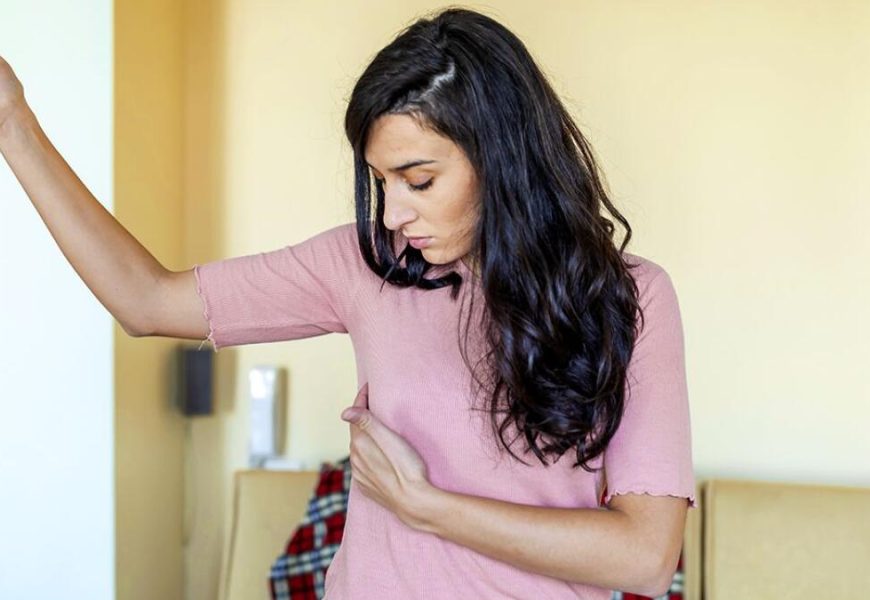Right breast pain can be caused by injuries, infections, muscle strains, inflammation, and gastrointestinal issues. Symptoms of underlying health conditions may occur. Strain and injury cause sharp pain under right breast, which usually goes away on its own. Right breast pain may also come from the stomach.
Right-Sided Breast Pain
Lung problems often cause right chest pain. Sharp right-side chest pain. This can worsen when inhaled. Along with right-side chest pain, you may have tightness or trouble breathing. Medicines treat many right-side chest pain causes. However, some require surgical treatment.
Causes of Pain Under Right Breast
Lung, muscle, bone, and digestive issues can cause right-side chest pain. Following are the common causes:
-
Pulmonary Embolism
A pulmonary artery in your lung can trap a blood clot from elsewhere. Pulmonary embolism (PE) patients often experience sharp pain that worsens with breathing. You may also have shortness of breath or a racing heart.
-
Shingles
The chickenpox virus can reactivate in people over 50. This virus causes shingles, a painful upper-body rash. It usually develops on one side of your chest.
-
Menstrual Cycle
Many people experience menstrual-cycle-related breast pain and tenderness. In this case, hormone changes cause pain. This is cyclic breast pain. This type of breast pain usually starts a week before a period and goes away. Cyclic breast pain affects both breasts and may cause:
- Discomfort, lumpiness
- Heaviness
- Burning/stinging pain
- Sharp pain
- Tenderness
- Tightness
-
Mastitis
Mastitis is a bacterial infection in the breast. Common symptoms:
- Sudden, intense pain and tenderness
- Inflammation
- Redness
- Itching
- Fever
- Nipple discharge
- Abscesses
Pain management in Dallas prescribes antibiotics for breast infections. People can also relieve breast pain by applying a warm cloth several times a day. If an abscess persists, a doctor may drain it. Do not try this at home.
-
Breast Cysts
Breast cysts are liquid-filled ovals or rounds. The majority of breast cysts are benign. Simple cysts are round and moveable under the skin. A doctor may drain a large, painful, or uncomfortable cyst. This requires a fine needle. A doctor may test the cells or fluid inside a cyst with irregular or scalloped edges or solid areas or debris.
-
Fibroid Breast Disease
Fibrocystic breast disease causes noncancerous breast lesions and is common. Lesions can cause breast pain and texture changes. Experts link estrogen and anti-estrogen medications to fibrocystic breast disease. Aspirin and ibuprofen may relieve mild pain. More severe cases may require stronger medications or cyst removal.
-
Hiatal Hernia & GERD
A hiatal hernia bulges your upper stomach through a diaphragm opening. Diaphragms have smaller openings to prevent stomach acid from entering the esophagus. This acid can splash back into the esophagus with a hiatal hernia, causing GERD. Sharp pain under right breast may indicate GERD. This can produce a squeezing sensation and radiate to nearby areas.
Other hiatal hernia-related GERD symptoms:
- Heartburn
- Bad breath
- Dry cough
- Breathing problems
- Issues with worn teeth and swallowing
-
Pleural Diseases
Pleurae are large, thin membranes folded into two layers. One layer covers the lungs, while the other lines the chest cavity. The pleural space separates these layers. Pleurisy, pleura inflammation, can rub the two layers together. This friction can cause sharp chest pain when coughing or breathing deeply. Various pleural disorders can cause sharp chest pain due to air, gas, fluid, or blood accumulation.
Others symptoms for pleural disorders include:
- Coughing
- Breathlessness
- Fatigue
- Chest tightness
Pleural disorder treatment depends on the cause and severity of symptoms.
-
Gallbladder
Bile from the liver is stored in the gallbladder, a small organ on the right side of the body. Gallstones can form if bile contains too much cholesterol or bilirubin or if the gallbladder doesn’t empty properly. Most gallstones pass harmlessly. However, gallstones can cause pain and inflammation by blocking bile flow in the bile ducts. These blockages cause gallbladder attacks or biliary colic. Gallbladder attacks cause upper right abdominal pain for several hours.
-
Pleurisy
Inflammation of the chest lining outside the lungs is pleurisy. If your right lung is affected, your breast will hurt. Generalized chest pain and deep breath-induced pain are other symptoms. Shallow breaths can reduce pain. Treatment depends on the cause.
-
Ribs Pain
Right breast pain can result from a rib injury. One or more tender spots and pain when deep breathing or twisting are other symptoms. Your doctor may advise you to rest after a rib injury. Avoid chest pressure while the rib heals. Most bruises and fractures heal in six weeks. Your doctor may also prescribe OTC NSAIDs. This includes:
- Take ibuprofen (Advil)
- Naproxen sodium (Aleve)
- Aspirin
-
IBS
IBS is a chronic large intestine disorder. Pain usually affects the lower abdomen, but it can spread to other areas. Visit your doctor if you suspect IBS for right breast pain. IBS treatment involves diet and lifestyle changes. Your doctor may suggest one of several medications that suit your needs.
Conclusion
Right breast pain is rarely a medical emergency and usually indicates illness or injury. Cancer, pleurisy, and gallbladder problems cause sharp pain under the right breast. A hernia, strained muscles, or broken ribs can cause it. Consult with a dr william moore so he can help you to identify the cause and recommend the best treatment.
















